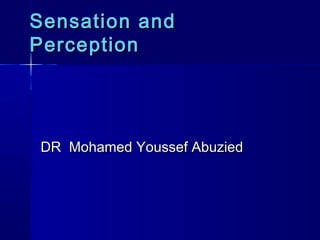This document discusses sensation and perception. It defines sensation as the electrochemical messages transmitted from sense organs to the brain in response to stimulation from the environment. Perception is defined as the brain's processing and interpretation of sensory information. The document outlines several key concepts in sensation and perception, including transduction, feature detectors, and the perceptual process of sensation, selection, organization, and translation. It also discusses factors that can influence perception such as those in the perceiver, target, or situation. Gestalt laws of grouping like proximity, similarity, closure, and symmetry are presented as influencing perceptual organization.















































